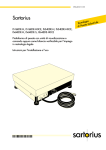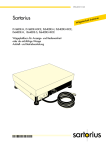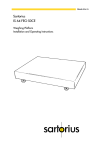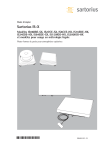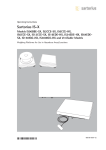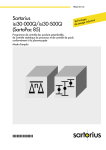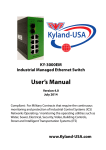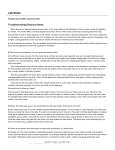Download Sartorius CIS3 Operating instructions
Transcript
98648-010-27 Sartorius IS16EDE-H, IS16EDE-H0CE, IS34EDE-H, IS34EDE-H0CE, IS64EDE-H, IS64EDE-S, IS64EDE-H0CE Weighing Platform for Display and Control Unit for Standard Use or Verified for Use in Legal Metrology Installation and Operating Instructions ial y Industr g Technolog in Weigh Contents General View of the Weighing Platform Intended Use Warranty Storage and Shipping Conditions Safety Instructions Page 3 4 4 4 4 Installation Instructions Ambient Conditions Conditioning the Weighing Platform IP65 Protection 5 5 5 5 Getting Started Setting Up the Weighing Platform Leveling the Weighing Platform Connecting the Weighing Platform Separate Power Connection for the Weighing Platform (Optional) Safety Precautions Fixed Power Connection Warmup Time Menu Access Switch 6 6 6 6 Operating Limits Maximum Overload Capacity Shock Resistance 9 9 9 General Instructions for Integration into Conveyor Systems Preload Range (Zero-setting Range) 10 10 Configuring the Weighing Platform 10 Specifications Charts 11 General Specifications 14 Selecting and Affixing the Respective ID Label Pin Assignment Chart for the RS-485 Interface Pin Assignments/Interface Connector 7 8 8 9 9 15 15 15 Troubleshooting Guide 16 Care and Maintenance Service Cleaning Wet Environment Corrosive Environment Safety Inspection Instructions for Recycling the Packaging 18 18 18 18 18 18 18 CE Marking 19 Declaration of Conformity Using the Weighing Platform in Legal Metrology Components of a Verifiable Weighing System 20 2 21 21 Page Separate Testing and Verification of Weighing System Components Effect of the Preload on Verifiability ”EC Verification” - A Service Offered by Sartorius Subsequent Verifications within the European Countries 21 21 22 22 EC Type Approval Certificate 23 Plates and Markings 26 Dimensions (Scale Drawings) 27 Accessories (Options) 28 General View General View of the Weighing Platform 1 2 3 4 5 9 6 8 7 No. Designation No. Designation 1 2 3 6 4 5 Load plate Manufacturer’s label Metrological ID labels (only on weighing platforms verifiable or verified for use in legal metrology) Leveling feet Level indicator 7 8 9 Connecting cable (interface port/power supply) Valve for barometric pressure compensation Blank for power supply cable gland (optional) Menu access switch (located behind the plug ) 3 Intended Use This weighing platform is part of a modular system that consists of the weighing module (weighing platform) and a display and control unit or isi industrial terminal. The display and control unit comes with a separate instruction manual. Before installing or operating your weighing equipment, please read all instructions thoroughly. Warranty Do not miss out on the benefits of our full warranty. Please contact your Sartorius office or dealer for further information. If available, complete the warranty registration card, indicating the date of installation, and return it to your Sartorius office or dealer. Storage and Shipping Conditions – Allowable storage temperature: – 10 °C to + 40°C + 14 °F to + 104 °F – Allowable humidity during storage: 90% relative humidity After unpacking the equipment, please check it immediately for any visible damage. If you detect any damage, proceed as directed in the section entitled “Safety Inspection.” It is a good idea to save the box and all parts of the packaging until you have successfully installed the equipment. Only the original packaging provides the best protection for shipment. To prevent damage to the equipment, unplug all cables before packing the equipment for shipping. Safety Instructions The equipment may be opened only by authorized service technicians who have been trained by Sartorius and who perform repair or maintenance work in accordance with Sartorius’ standard operating procedures. – Always disconnect the equipment from power before performing any repair work. – Do not use the weighing platform in a hazardous area/location. – Do not operate the equipment in environments exposed to potentially explosive mixtures of ambient gases and dust. – Any damage to the seals affixed to the equipment housing will result in forfeiture of all claims under the manufacturer’s warranty. Note: This equipment has been tested and found to comply with the limits for a Class A digital device, pursuant to Part 15 of the FCC rules. These limits are designed to provide reasonable protection against harmful interference when the equipment is operated in a commercial environment. This equipment generates, uses and can radiate radio frequency energy and, if not installed and used in accordance with the instruction manual, may cause harmful interference to radio communications. Operation of this equipment in a residential area is likely to cause harmful interference in which case the user will be required to correct the interference at his own expense. Changes or modifications not expressly approved by Sartorius could void the user’s authority to operate the equipment. 4 Installation Instructions Installation Instructions The equipment must be installed and put into operation by a trained Sartorius dealer or service technician, who will also show you how to work with it. Ambient Conditions Choose a suitable place to set up the weighing platform. Avoid exposing the weighing platform to the following ambient conditions: – Extreme heat radiation – Extreme vibration – Aggressive chemical vapors – Difficulty of access for maintenance and cleaning Important: If you need to use the weighing platform in an area exposed to heavy traffic (e.g., fork-lift trucks), you should install a protective frame, consisting of angular braces, around the weighing platform. To calculate the dimensions for this protective frame, refer to the section entitled “Dimensions (Scale Drawings).” Conditioning the Weighing Platform Do not expose the weighing platform to extreme moisture over long periods. Moisture in the air can condense on the surfaces of a cold platform whenever it is brought to a substantially warmer place. If you transfer the weighing platform to a warmer area, make sure to condition it for about 2 hours at the new ambient temperature, leaving it unplugged from the power supply. Afterwards, if you keep the weighing platform connected to the power supply, the continuous positive difference between the inside of the platform and the outside will practically rule out the effects of moisture condensation. IP65 Protection In conformance with the IP65 protection rating, the weighing platform is dusttight (protection rating 6: resistant to penetration by dust particles, according to particle size) and washdown-resistant (rating 5: resistant to splashes of water, washdown-resistant). IP65 protection is guaranteed only if: – the seals were installed by a qualified technician, and – the connecting cables and cable glands were installed and connected by a qualified technician. 5 Getting Started Setting Up the Weighing Platform - Remove the weighing platform and load plate from the packaging - Remove the foam material and manufacturer’s labels - Place the load plate on the weighing platform Leveling the Weighing Platform Level the weighing platform at the place of installation using the leveling feet (4) so that the air bubble is centered within the circle of the level indicator (5): To raise the weighing platform, extend the leveling feet (turn clockwise). To lower the weighing platform, retract the leveling feet (turn counterclockwise). Make sure all four feet are in contact with the surface on which the platform stands. Important: - Do not perform any installation work while the equipment is connected to power. - Installation work that affects the IP65 protection rating must be performed with extreme care. - Always disconnect the equipment from power before connecting or disconnecting the data cable. - Failure to observe the instructions contained in this manual during installation will result in forfeiture of all claims under the manufacturer’s warranty. Connecting the Weighing Platform Please note that any person or company connecting a non-Sartorius-approved display and control unit (such as a computer) or AC adapter to the weighing platform shall assume all risks and responsibilities associated with this equipment. Use only original Sartorius AC adapters. The connecting cable is 3 meters long (approx. 10 feet). To order an extension cable or a customized cable, refer to the list of accessories or contact Sartorius. Cable Lengths: Because you can choose whether to power the weighing platform via the interface port of the display and control unit or using a separate AC adapter (adapter kit required; must be installed by a Sartorius service technician), some restrictions apply to the cable lengths permissible between components. If you use a cable longer than 12 meters (∼ 40 feet) between the weighing platform and the display and control unit, each of these components must be powered by a separate AC adapter. 6 Getting Started Separate Power Connection (Optional) for the Weighing Platform An adapter kit must be installed by a Sartorius dealer or service technician to connect the weighing platform separately to line current (mains supply). In addition, this separate power connection is required if you interface the weighing platform directly with a computer. The following diagrams show the options for powering weighing platforms and display and control units: max 3 m Connecting the industrial-grade ING2 AC adapter to the Sartorius isi industrial terminal without an extension cord: max 3 m Connecting the industrial-grade ING2 AC adapter only to the isi industrial terminal with an extension cord: 3m 6m Connections using cables longer than 12 m (~40 ft): 300 m max. 7 The weighing platform is powered by the external industrial-grade ING 2 AC adapter (see “Accessories”). Make sure that the voltage rating printed on this unit is identical to your local line voltage. If the voltage specified on the label or the plug design does not match the rating or standard you use, please contact your local Sartorius office or dealer. To use a main feeder cable from the ceiling or to mount a CEE plug, you will have to make arrangements inside your facilities for installation of such cable equipment. Use only original Sartorius AC adapters, identified by the Sartorius label. Use of AC adapters from other manufacturers, even if these units have an approval identification marking from a national testing laboratory, requires the consent of a trained service technician. For detailed information on further options for powering the equipment (e.g., using local low voltage), contact Sartorius headquarters in Germany or one of the main offices based in your country. The equipment must be connected to power in conformance with the installation requirements of your country. Safety Precautions The Sartorius power supply rated to Industrial Class 2 (with safety extra-low voltage emission (SELV)) can be plugged into any electrical outlet without additional safety precautions. The ground or earth terminal is connected to the platform housing, which can be additionally grounded, if required. Install the power cable with adequate protection to prevent damage to the cable. Fixed Power Connection If the power cable is permanently installed or secured so that it cannot be unplugged, an emergency switch must be installed for disconnecting power to the equipment. This emergency switch must be located near the weighing platform and must be easily accessible. In addition, this switch must be labeled as an emergency switch. All operators must be instructed in the use of this switch. Whenever possible, avoid wiring your weighing platform into networks that carry a heavy load (such as a connection to a compressor or similar equipment). 8 Getting Started Warmup Time To deliver exact results, the weighing platform must warm up for at least 30 minutes after initial connection to AC power or after a relatively long power outage. Only after this time will the weighing platform have reached the required operating temperature. Preparing the Weighing Platform for Verification for Use in Legal Metrology in the EU:* Allow the weighing platform to warm up for at least 24 hours after initial connection to the power supply. * including the Signatories of the Agreement on the European Economic Area Menu Access Switch Prior to Verification: – All settings in the operating menu are accessible (once the weighing platform has been verified for use in legal metrology, menu items relevant to legal metrology are blocked) – Select configuration settings from corresponding specifications group (configuration cannot be changed after verification) – Block the ‘write’ function for the xBPI interface Function of the Menu Access Switch in Verification for Use in Legal Metrology: When the menu access switch (9) is open, weighing ranges can be configured and calibration/adjustment can be performed, prior to verification. After Verification: Move the menu access switch (9) to the left. Configuration settings relevant to use of the weighing platform in legal metrology are no longer accessible. Operating Limits Maximum Overload Capacity Because Sartorius weighing platforms are constructed to withstand rough treatment in industrial environments, the platform will not be damaged if occasionally loaded beyond the maximum weighing capacity. The maximum overload capacity of this IS model is 130 kg. Shock Resistance Even though Sartorius weighing platforms feature highly rugged construction, there are some limits. Avoid dropping objects from a considerable height onto the weighing platform and do not expose the platform to strong side impact. Sartorius weighing platforms are shock resistant in accordance with the shock response spectrum defined in the IEC68 standard, Part 2-27. 9 General Instructions for Integration into Conveyor Systems The IS weighing platform is suitable for installation in conveyor systems. Follow the general instructions given below and refer to the “Dimensions (Scale Drawings)” to meet the requirements for such installation. – Any moving or rotating parts intended to be permanently attached to the load plate must be designed so that they cannot negatively affect the accuracy of weighing results. For example, rotating mechanisms must be properly balanced. – The load plate must be clear on all sides so that any parts or any dirt that falls will not create a connection between the weighing platform and any permanently mounted preload components. – Any cables or tubing between the weighing platform and other equipment must not apply any force to the weighing platform. Make sure that cables do not touch the load plate. – Do not install the weighing platform in a conveyor system located in a Zone 2 or 11 hazardous area/location. Preload Range (Zero-setting Range) The weight of components that are permanently installed on the weighing platform is called “preload.” The weighing platform electrically compensates for this preload so that the entire weighing range is available and the platform can be zeroed and can also be calibrated/adjusted using external weights. Higher preloads may result in a reduction in the maximum weighing capacity. The maximum preload that can be compensated for depends on the specifications configured (please see the “Specifications Chart”). The preload must be set before the platform is verified for use in legal metrology. The components for integration into a conveyor must be installed on the weighing platform before you connect the platform to the power supply. Configuring the Weighing Platform If you have a standard-model weighing platform, you can adapt it for specific requirements such as weighing in international weight units, use under unfavorable ambient conditions, or further processing of weighing results, for example. If your weighing platform is to be verified for use in legal metrology, one weight unit must be selected before verification, and cannot be changed after verification has been performed. You can customize the weighing platform (weighing module) via the Configuration menu using a connected display and control unit, or using a connected computer with special Sartorius configuration software (see accessories). The configuration options for your weighing platform are listed in the “Specifications Chart” on the following pages. 10 Specifications Chards Specifications Charts Access the configuration menu of the connected Sartorius terminal or display and control unit of your choice. You need to set the appropriate codes before verification of the platform as a legal measuring instrument. Please note that when you change the configuration, this may also change the accuracy class besides the weighing capacity and the readability. I IS16EDE-H0CE (Type of weighing instrument: iso-TEST + BF BF or SARTOCOWAT + BF BF) verifiable for use in legal metrology. Specifications group Spec. gp.1* Spec. gp.2 Spec. gp.3 Spec. gp.4 (code): (10 3 1) (10 3 2) (10 3 3)5) (10 3 4)5) Spec. gp.5 (10 3 5) Spec. gp.6 (10 3 6) 12.1 Maximum capacity kg 16 6.1 3.1 12.1 16 Readability g 0.1 0.1 0.1 0.5 0 to 6 kg: 0.1 0 to 6 kg: 0.1 6 to 16 kg: 1 6 to 12.1 kg: 1 Standard Configurable Configurable Configurable Configurable Zero tracking±2% kg ±0.32 ±0.12 ±0.06 ±0.24 ±0.32 ±0.24 Initial zero-setting range kg ±1 ±1 ±1 ±1 ±1 ±1 Preload 1) kg 4 14 17 8 4 8 yes yes yes yes yes yes Weighing range 2 isoTEST function ) Configurable Metrological specifications Accuracy class kg K K Standard Standard K K Minimum capacity acc. to CD 3) g 5 5 – – 5 5 Minimum capacity acc. to AWC4) g 150 150 – – 150 150 Verification scale interval g 1 1 – – 1 1 Temperature range °C +10 to +30 +10 to +30 +10 to +30 +10 to +30 +10 to +30 +10 to +30 1 ) No reduction in the maximum capacity up to this preload; higher preloads reduce the maximum capacity in 0.1-kg steps 2) The isoTEST function cannot be selected for preloads > approx. 18 kg 3 ) CD = Council Directive 2009/23/EC on non-automatic weighing instruments used in the EU and the Signatories of the Agreement on the European Economic Area 4) AWC = average weight control based on the requirements of the German Regulations for Prepackaged Products 5 ) Not allowed for use in legal metrology (legal for trade). A 10-kg calibration weight is required for external adjustment. * = factory setting IS16EDE-H0CE (Type of weighing instrument: iso-TEST + BF BF or SARTOCOWAT + BF BF) verifiable for use in legal metrology. Specifications group (code): Spec. gp.7 (10 3 7) Spec. gp.8 (10 3 8) Spec. gp.9 (10 3 9) Spec. gp.10 (10 3 10) Spec. gp.11 (10 3 11) Spec. gp.12 (10 3 12) Maximum capacity kg 16 16 12.1 16 6.1 3.1 Readability g 0 to 3 kg: 1 3 to 6 kg: 2 6 to 16 kg: 5 2 2 5 2 1 Standard Configurable Configurable Configurable Configurable Configurable Zero tracking±2% kg ±0.32 ±0.32 ±0.24 ±0.32 ±0.12 ±0.06 Initial zero-setting range kg ±1 ±1 ±1 ±1 ±1 ±1 Preload 1) kg 4 4 8 4 14 17 yes yes yes yes yes yes Weighing range isoTEST function2) Metrological specifications Accuracy class kg l l l l l Standard Minimum capacity acc. to CD 3) g 20 40 40 100 40 – Minimum capacity acc. to AWC4) g 150 500 500 2500 500 – Verification scale interval g 1/2/5 2 2 5 2 – Temperature range °C +10 to +40 +10 to +40 +10 to +40 +10 to +40 +10 to +40 +10 to +40 1) No reduction in the maximum capacity up to this preload; higher preloads reduce the maximum capacity in 0.1-kg steps. You cannot set a preload > 17 kg. 2 ) The isoTEST function cannot be selected for preloads > approx. 18 kg 3) CD = Council Directive 2009/23/EC on non-automatic weighing instruments used in the EU and the Signatories of the Agreement on the European Economic Area 4 ) AWC = average weight control based on the requirements of the German Regulations for Prepackaged Products 5) Not allowed for use in legal metrology (legal for trade). A 10-kg calibration weight is required for external adjustment. 11 IS34EDE-H0CE (Type of weighing instrument: iso-TEST + BF BF or SARTOCOWAT + BF BF) verifiable for use in legal metrology. Specifications group (code): Spec. gp.1 (10 3 1) Spec. gp.2* (10 3 2) Spec. gp.3 (10 3 3) 34 26.1 Maximum capacity kg 34 Readability g 0.1 Standard Configurable Configurable Zero tracking±2% kg ±0.68 ±0.68 ±0.52 Initial zero-setting range kg ±1 ±1 ±1 Preload 1) kg 4 4 yes yes Weighing range isoTEST function2) Spec. gp.4 (10 3 4) 34 Spec. gp.5 (10 3 5) Spec. gp.6 (10 3 6) 26.1 34 1 6 to 34 kg 1 0 to 6 kg 0.1 Configurable Configurable Configurable ±0.68 ±0.52 ±0.68 ±1 ±1 ±1 12 4 12 4 yes yes yes yes 0 to 6kg: 0.1 0 to 6kg: 0.1 1 6 to 15kg: 0.2 6 to 15kg: 0.2 15 to 34kg: 0.5 15 to 26.1kg: 0.5 Metrological specifications Accuracy class kg K K K K K K Minimum capacity acc. to CD 3) g 5 5 5 50 50 5 Minimum capacity acc. to AWC4) g 150 150 150 150 150 150 Verification scale interval g 1 1 1 1 1 1 Temperature range °C 10 to +30 +10 to +30 +10 to +30 +10 to +30 +10 to +30 +10 to +30 1 ) No reduction in the maximum capacity up to this preload; higher preloads reduce the maximum capacity in 1-kg steps. You cannot set a preload > approx. 31 kg. 2) The isoTEST function cannot be selected for preloads > approx. 21 kg 3 ) CD = Council Directive 2009/23/EC on non-automatic weighing instruments used in the EU and the Signatories of the Agreement on the European Economic Area 4) AWC = average weight control based on the requirements of the German Regulations for Prepackaged Products 5 ) Not allowed for use in legal metrology (legal for trade). A 10-kg calibration weight is required for external adjustment. * = factory setting IS34EDE-H0CE(Type of weighing instrument:iso-TEST + BF BF or SARTOCOWAT + BF BF)verifiable for use in legal metrology. Specifications group (code): Maximum capacity kg Readability g Weighing range Spec. gp.6 (10 3 6) Spec. gp.7 (10 3 7) Spec. gp.8 (10 3 8) Spec. gp.9 (10 3 9) 34 26.1 34 26.1 0 to 6 kg: 2 0 to 6 kg: 2 5 6 to 15 kg: 5 6 to 15 kg: 5 15 to 34 kg: 10 15 to 34 kg:10 5 Configurable Configurable Configurable Configurable Zero tracking±2% kg ±0.68 ±0.52 ±0.68 ±0.52 Initial zero-setting range kg ±1 ±1 ±1 ±1 Preload 1) kg 4 12 4 12 yes yes yes yes l l l l g 40 40 100 100 500 500 2500 2500 isoTEST function2) Metrological specifications Accuracy class kg Minimum capacity acc. to CD 3) Minimum capacity acc. to AWC4) g Verification scale interval g 2/5/10 2/5/10 5 5 Temperature range °C +10 to +40 +10 to +40 +10 to +40 +10 to +40 1) No reduction in the maximum capacity up to this preload; higher preloads reduce the maximum capacity in 1-kg steps. You cannot set a preload > approx.31 kg. 2 ) The isoTEST function cannot be selected for preloads > approx. 21 kg 3) CD = Council Directive 2009/23/EC on non-automatic weighing instruments used in the EU and the Signatories of the Agreement on the European Economic Area 4 ) AWC = average weight control based on the requirements of the German Regulations for Prepackaged Products 5) Not allowed for use in legal metrology (legal for trade). A 10-kg calibration weight is required for external adjustment. * = factory setting 12 Specifications Chards IS 64 EDE-H0CE (Type of weighing instrument: iso-TEST + BF BF or SARTOCOWAT + BF BF) verifiable for use in legal metrology. Specifications group (code): Spec. gp.1* (10 3 1) Spec. gp.2 (10 3 2) Spec. gp.3 (10 3 3)4) Spec. gp.4 (10 3 4)4) 16 Maximum capacity kg 64 51 31 Readability g 1 1 1 Standard Configurable Configurable Weighing range 1 Configurable Zero tracking±2% kg ±1.3 ±1 ±0.6 ±0.3 Initial zero-setting range kg ±1.3 ±1.3 ±1.3 ±1.3 Preload 1) kg 13 26 46 61 yes yes yes yes isoTEST function2) Metrological specifications Accuracy class kg K K Standard Standard Minimum capacity acc. to CD 3) g 50 50 – – Minimum capacity acc. to AWC4) g 10000 10000 – – Verification scale interval g 10 10 – – Temperature range °C 0 to +40 0 to +40 0 to +40 0 to +40 1 ) No reduction in the maximum capacity up to this preload; higher preloads reduce the maximum capacity in 1-kg steps. You cannot set a preload > approx.14 kg. 2 ) The isoTEST function cannot be selected for preloads > approx. 36 kg 3) CD = Council Directive 2009/23/EC on non-automatic weighing instruments used in the EU and the Signatories of the Agreement on the European Economic Area 4 ) AWC = average weight control based on the requirements of the German Regulations for Prepackaged Products * = factory setting IS 64 EDE-H0CEH0CE (Type of weighing instrument: iso-TEST + BF BF or SARTOCOWAT + BF BF) verifiable for use in legal metrology. Specifications group (code): Maximum capacity kg Readability g Weighing range Spec. gp.5 (10 3 5) Spec. gp.6 (10 3 6) Spec. gp.7 (10 3 7) Spec. gp.8 (10 3 8) Spec. gp.9 (1039) 64 64 64 31 16 0 to 15 kg: 5 10 15 to 30 kg:10 30 to 64 kg:20 20 10 5 Configurable Configurable Configurable Configurable Configurable Zero tracking±2% kg ±1.28 ±1.28 ±1.28 ±0.6 ±0.3 Initial zero-setting range kg ±1.3 ±1.3 ±1.3 ±1.3 ±1.3 Preload 1) kg isoTEST function2) 13 13 13 46 61 yes yes yes yes yes Metrological specifications Accuracy class kg l l l l l Minimum capacity acc. to CD 3) g 100 200 400 200 100 Minimum capacity acc. to AWC4) g 2500 10000 15000 10000 2500 Verification scale interval g 5/10/20 10 20 10 5 Temperature range °C 0 to +40 0 to +40 0 to +40 0 to +40 0 to +40 1) No reduction in the maximum capacity up to this preload; higher preloads reduce the maximum capacity in 1-kg steps. You cannot set a preload > approx.14 kg. 2) The isoTEST function cannot be selected for preloads > approx. 36 kg 3) CD = Council Directive 2009/23/EC on non-automatic weighing instruments used in the EU and the Signatories of the Agreement on the European Economic Area 4 ) AWC = average weight control based on the requirements of the German Regulations for Prepackaged Products * = factory setting 13 General Specifications (applicable for use in standard applications, not in legal metrology) Model IS 16 EDE-H IS 34 EDE-H IS 64 EDE-S IS64EDE-H Maximum capacity kg 16 34 64 64 Readability g 0.1 0.1 1 0.1 Linearity g Repeatability (standard deviation) g ≤±0.2 ≤±0.05 ≤±0.2 ≤±0.1 ≤±0.5 ≤±0.3 ≤±0.3 ≤±0.1 Response time (average) s <1.5 <1.5 <1 <1.5 <1 <1 <0.8 <0.8 Fastest response time (IQ) s Adaptation to ambient conditions and application requirements by selection of one of 4 optimized filter levels Data output speed (depends on filter level selected) 0.1, 0.1, 0.2, 0.4 (normal data output speed) Dust and water protection rating IP65 IP65 IP65 IP44* Net weight, approx. 15 15 15 15 kg Requirements for power connection (optional) ING2 (TNG 220/115V) Frequency Hz 48 - 63 48 - 63 48 - 63 48 - 63 Power consumption: with isi 10,20,30 connected to ING2) VA max. 34 average 10 max. 34 average 10 max. 34 average 10 max. 34 average 10 average 2.5 average 2.5 average 2.5 Power consumption: weighing platform only, VA average 2.5 connected to ING2 Selectable weight units g, kg, ct, oz, ozt, tlh, tlt, GN, dwt, mg, /lb, tlc, mom, K, tol, bat, MS Allowable ambient temperature range °C +0 to +40 (273 K - 313 K) +0 to +40 (273 K - 313 K) +0 to +40 +0 to +40 (273 K - 313 K) (273 K - 313 K) Allowable operating temperature range °C +10 to +30 (283 K - 313 K) +10 to +30 (283 K - 313 K) +10 to +30 +10 to +30 (273 K - 313 K) (273 K - 313 K) °C Standard feature Standard feature Standard featureStandard feature Automatic zero tracking, can be turned off by menu code Built-in interface, RS-485 (standard, xBPI protocol): 8 bits; odd parity; transmission speed: 9600–38,400 baud; half-duplex. Convertible to RS-232 (SBI protocol): 7 bit; parity: even, mark, odd, space; transmission speed: 150–19,200 baud; 1 or 2 stop bits; software/hardware handshake. Factory setting: 1200 baud; odd parity; 1 stop bit; hardware handshake with 2 characters after CTS *) = IP 65 (special version available on request) 14 Specifications Chards Pin Assignment Chart for the RS-485 Interface Cable length: 3 m (approx. 10 ft.) Male connector: Type C091D, 12-pin round connector with threaded locking ring, Amphenol (IP65) A B C D E F G H J K L M RxD-TxD-N Not connected Not connected Not connected Signal GND Menu access switch for calibration/adjustment (routed externally) VCC (24V power supply) Not connected GND (24V power supply) GND (24V power supply) RxD-TxD-P VCC (24V power supply) Pin Assignments/Interface Connector (Recommended): Type C091D, 12-pin, Amphenol (IP65) Type of cable: AWG 24 specification Be sure to follow the instructions above for connecting the weighing platform to the power supply! 15 Troubleshooting Guide Problem No segments appear on the display Possible Causes No line current is available The AC adapter is not plugged in The weighing platform has been in standby mode for more than 5 minutes The weight display shows “H” The load exceeds the capacity of the weighing platform Solution Check the power supply Plug the AC adapter into the platform and into an electrical outlet Turn on the display and control unit Unload the weighing platform The weight display shows “L” or The load plate is not on the ”Err 54" platform Place the load plate on the weighing platform The weight display briefly indicates “Err 01” The weight unit selected requires more decimal places than are available in the display Change setting in the “Devices” setup menu of the display and control unit The weight display briefly indicates “Err 02” One of the requirements for calibration/adjustment has not been met (e.g., the weighing platform is loaded) Possible solutions: - Zero the weighing platform. - Unload the weighing platform (Calibrate/ adjust the weighing platform only when a zero readout is displayed) The weight display briefly indicates “Err 03” Calibration/adjustment could not be completed within a specific time Allow the equipment to warm up and start calibration/adjustment again The error code “ERR 07” is The last function you activated is not allowed for weighing plat- contact your local dealer or forms used in legal metrology (legal for trade) The error code “ERR 08” is platform is too heavy for the The load on the weighing range for the configuration platform to be zeroed The error code “ERR 09” is The gross value is < zero and the platform is unloaded, but it is not range for the configuration possible to tare the platform 16 To change the menu codes, displayed service technician Check the initial zero-setting displayed code you have selected from the “Specifications Charts”, to determine whether this range is correct Check the initial zero-setting displayed code you have selected from the “Specifications Charts”, to determine whether this range is correct The error code “ERR 10” is displayed There are values stored in the tare memories for your application, and you tried to clear the lowerlevel tare memory Clear the tare memories for your application first, then clear the lower-level tare memory The error code “ERR 12” is displayed You tried to store a value in the tare memory for applications, although this memory has been blocked by menu code 2 2 x Check the configuration You entered a numeric tare that is not allowed Check the number you have entered and correct it, if necessary The error code “ERR 17” is displayed Internal calibration is not possible because the preload setting is too high Reduce the preload or select a different configuration code The error code “ERR 19” is displayed The remaining weighing capacity available is too low because the relatively high preload setting has reduced the maximum capacity Reduce the preload The special code “b” remains displayed None of the keys has been pressed since the weighing platform was switched on Press any key The weight readout changes constantly Unstable environment (ambient conditions; e.g., too much vibration or exposure to excessive drafts) Set up the weighing platform in a different area Access the “Devices” setup menu to adapt the weighing platform to the particular environment A foreign object is caught between the load plate and the platform frame Remove the foreign object The weighing platform was not adjusted/calibrated before weighing The weighing platform is not level Adjust/calibrate the weighing platform The readout of the weighing result is obviously wrong Level the weighing platform as described in the instructions If any other errors occur, please contact your local Sartorius dealer or Sartorius Service Center. 17 Care and Maintenance Service Regular servicing by a Sartorius technician will extend the service life of your weighing platform and ensure its continued weighing accuracy. Sartorius can offer you service contracts, with your choice of regular maintenance intervals ranging from 6 months to 2 years. Cleaning Before cleaning the weighing platform, disconnect it from the power supply (e.g., unplug the AC adapter). To clean the weighing platform when it has been exposed to dry ambient conditions: – Use a piece of cloth dampened with a commercially available cleaning agent to wipe down the weighing platform Wet Environment: To clean the weighing platform when it has been in a wet environment: – Use a commercially available cleaning agent and hose down the platform afterwards. In conformance with the IP65 protection rating, the weighing platform is washdown resistant. However, the applicable standards (EN 60529 and, in Germany, DIN VDE 0470 T1) do not allow the use of pressurized water (such as strong jets of water using a hose or high-pressure cleaning equipment). When spraying down the weighing platform, avoid directing strong jets of water at the 4 silicone gaskets beneath the load plate so that they are not torn by the water pressure. Never use concentrated acids, bases, solvents or pure alcohol to clean the weighing platform! Corrosive Environment To clean the weighing platform exposed to a corrosive environment: – Regularly remove all traces of corrosive substances from the platform – Follow the manufacturer’s directions provided for the disinfectants and cleaning agents you use to clean the weighing platform Important Note: If the water that you use to clean the weighing platform is too hot or too cold, the difference in temperature between the water and the platform can cause condensation within the platform. This condensation may cause the weighing platform to malfunction. Safety Inspection If there is any indication that safe operation of the weighing platform is no longer warranted, turn off the power and disconnect it from the power supply immediately. Lock the equipment is a secure place to ensure that it cannot be used for the time being. Safe operation of the weighing platform with the AC adapter is no longer ensured when – there is visible damage to the AC adapter – the AC adapter no longer functions properly – the AC adapter has been stored for a relatively long period under adverse conditions 18 Care and Maintenance In this case, notify your nearest Sartorius Service Center or the International Technical Support Unit based in Goettingen, Germany. Maintenance and repair work may be performed only by authorized Sartorius service technicians who have access to the required maintenance manuals and have attended the relevant service training courses. Instructions for Recycling the Packaging Sartorius products are packaged to ensure safe shipment using environmentally friendly materials. After successful installation of the equipment, you should return this packaging for recycling. For information on recycling options, including recycling of old weighing equipment, contact your municipal waste disposal center or local recycling depot. C Marking The C marking affixed to the equipment indicates that the equipment meets the requirements of the following Directive(s): Council Directive 89/336/EEC “Electromagnetic Compatibility (EMC)” Applicable European Standards: Limitation of emissions: EN 50081-1 Residential, commercial and light industry EN 50081-2 Industrial environment Defined immunity to interference: EN 50082-1 Residential, commercial and light industry EN 50082-2Industrial environment Important Note: The operator shall be responsible for any modifications to Sartorius equipment (not permitted on equipment to be verified) and for any connections of cables or equipment not supplied by Sartorius and must check and, if necessary, correct these modifications and connections. On request, Sartorius will provide information on the minimum operating specifications (in accordance with the Standards listed above for defined immunity to interference). Pursuant to the German Directive for the Implementation of Regulations for Prevention of Accidents, “Elektrische Anlagen und Betriebsmittel (VBG 4)” (electrical installations and equipment) of April 1986, it is hereby certified that the equipment delivered has been manufactured and tested in compliance with the following DIN/VDE regulations: DIN IEC 348/VDE 0411 Safety requirements for electronic measuring apparatus DIN IEC 380/VDE 0806 Safety of electrically energized office machines DIN IEC 601/VDE 0750 Safety of medical electrical equipment and with Article 73/23/EEC, European Community Low Voltage Directive of 19 February 1973. When you use electrical equipment in installations and under ambient conditions requiring higher safety standards, you must comply with the provisions as specified in the applicable regulations for installation in your country. 19 20 Declaration of Conformity Use of the Weighing System in Legal Metrology in the EU Components of a Verifiable Weighing System Your weighing platform is a modular device. The weighing system in which this weighing platform is connected is verifiable for use in legal metrology only if this platform is combined with a suitable terminal or with a PC running Sartorius software (“Winscale”). The weighing platform or weighing system may not be used for weighing goods intended for direct sale to the public, and may not be used in legal metrology prior to the initial verification. The type-approval certificate for verification applies to non-automatic weighing instruments and, in Germany, to automated weighing instruments used in noncontinuous weighing with or without control functions. Thus a verified weighing system can consist of – an isi industrial terminal + 1 to 3 IS weighing platforms or – an isi industrial terminal + at least one IS weighing platform + up to 2 additional weighing instrument that have undergone EU or national verification. The weighing instrument may not be used for weighing goods intended for direct sale to the public. The type-approval certificate for verification applies to non-automatic weighing instruments only; for automatic operation with or without auxiliary devices installed, you must comply with your country’s national regulations applicable at the place of installation of your weighing instrument. Effect of the Preload on Verifiability (The preload can be changed only prior to verification!) Only internal adjustment (calibration) is allowed for weighing instruments verified for use in legal metrology (see “Effect of the Preload on Internal Calibration/Adjustment”). The preload can be changed only prior to verification. The legal basis permitting Sartorius to perform initial verification is constituted by the following: 1) EC council directive no. 2009/23/EC on non-automatic weighing instruments, which has been applicable within the harmonized Single Market of the European Union since 1 January 1993; and 2) the certificate issued by the Metrology Department “Eichwesen” of the Landesverwaltungsamt (administrative offices) of Lower Saxony in Germany ( now MEN, Mess- und Eichwesen Niedersachsen ). 21 Approved Auxiliary Measuring Devices If the weighing system is used in legal metrology, any auxiliary devices connected must also be verifiable. Auxiliary devices that are metrologically relevant, such as printers, remote display units, or the like, must have the metrology label (black “M” on a green background). The auxiliary device must be verified at the same time that the entire system is verified. In Germany, if an auxiliary device is connected at a later date to a verified system already in operation, the appropriate weights and measures office must be notified; the auxiliary device may be used in legal metrology directly following installation, however, provided that it is installed in accordance with applicable regulations and that it bears the green metrology sticker referred to above. “EC Verification” - A Service Offered by Sartorius Our service technicians authorized to perform the verification of your weighing instruments that are acceptable for legal metrological verification can inspect and verify the metrological specifications at the place of installation within the Member States of the European Union and the Signatories of the Agreement on the European Economic Area. Subsequent Verifications within the European Countries The validity of the verification will become void in accordance with the national regulations of the country in which the weighing instrument is used. For information on verification and legal regulations currently applicable in your country, and to obtain the names of the persons to contact, please contact your local Sartorius office, dealer or service center. 22 23 24 25 26 27 28 Selecting and Attaching ID Plates The ID plate is to be selected and attached according to the specification block (configuration of scales) and the display and control unit (terminal). For details of how to position the ID plate on the scales or tag holder, refer to the instructions in "Plates and Markings". If display and control units (terminals) of type TA, models CAIS1, CAISL1, CAIS2, CAISL2, CAIS3, CAISL3 are being used, EC Type Approval Certificate No. T7899, type SARTOCOWAT is applicable. ID plate for class configurations ID plate for class configurations If display and control units (terminals) of type TN, models CIS2, CSL2, CIS3, CISL3, type TN-X, model CISX3, type TN-Pro, model Combics Pro, type isi10, isi20, isi30, type YAC01LA, type YAC01LP, type YAC01FC, type YAC02FC, PC with Sartorius Win Scale software EC Type Approval Certificate No. D97-09-018, type iso-TEST is applicable. ID plate for class configurations ID plate for class configurations Select and Attach Plate Containing Metrological Data Plates with the metrological data Max, Min e and d must also be attached near to the display. Select the plate with the Max, Min e and d metrological data that is suitable for the configuration, cut along the dotted lines and attach above the display. The transparent protective film must be stuck over the plate containing the metrological data. The tamper-proof plate containing the metrological data does not need verification seals. Examples of attached plates containing metrological data for the possible configurations. 29 Plates and Markings Dimensions (Scale Drawings) All dimensions given in millimeters 300 120.2 53 400 Ø35 265 53 365 31 Accessories (Options) Order No.: Data interface port with 3-m cable (IP67, RS-485) and round connector (electrically isolated) YDO 59 IS Data interface port with 3-m cable (IP67, RS-232C/ YDO 58 IS RS-423) and round connector (electrically isolated) Extension cable with round male and female connectors (IP65, 6 m) YCC 01-ISM6 Round female connector, IP65, type C091D, 12-contact, Amphenol 69 QC0011 Round male connector, IP65, type C091D, 12-pin, Amphenol 69 QC0010 Adapter cable, from round connector to PC, 25-pin D-Submini; length: 0.25 m (approx. 10 in.) (YDO58IS interface port required) YCC 01-0017D2 PC adapter cable, 25-pin D-Submini to 9-contact 69 65619 D-Submini; length: 0.2 m (approx. 8 in.) (YDO 52 IS interface port and YCC 01-0017D2 adapter cable required) To order customized accessories or custom solutions, please contact the Sartorius “Fast Factory”. 32 Accessories Order No.: Stainless steel tag plate for metrological ID labels (fastens to cable; required when weighing platform is used for legal metrology in a weighing system) YAS 01 IS Adapter kit for DC power supply to YAS 03 IS the weighing platform (without using an external AC adapter or power supply) IP67 cable gland (to be installed by an authorized service technician only) External rechargeable battery pack; hours of operation: approx. 28 (without isi terminal) (YAS03IS adapter kit required) YRB 06 Z IP65 AC adapter; 3-m primary cable, 1.5-m secondary cable; to be installed by an authorized service technician only (YAS03IS adapter kit required) for 220 V for 110 V 69 71899 69 71500 Adapter cable for connecting the weighing YRB 01 IS platform to a 12-V car battery or to a separate 12-V power source using the terminal leads; cable length: 3.7 m (approx. 12 ft.); with integrated switch and fuse, reverse battery polarity protection; must be installed by an authorized service technician using the YAS03IS adapter kit. Roller conveyor, with 7 rollers Aluminum Stainless steel YRC 01 EDA YRC 01 EDS Calibration weight (1 · 10 kg, accuracy class F1) YCW 7138 (with weighing platforms verified for use in legal metrology, the calibration weight is used as a test weight only) Configuration diskette for the IS weighing YAD 01 IS platform (PC, DOS), without interface cable Hanger for under-scale weighing 69EA0040 To order customized accessories or custom solutions, please contact the Sartorius “Fast Factory”. 33 Sartorius Weighing Technology GmbH 37075 Goettingen, Germany Weender Landstrasse 94 - 108, 37075 Goettingen, Germany (+49/551) 308-0, (+49/551) 308-3289 Internet: http://www.sartorius-mechatronics.com Copyright by Sartorius Weighing Technology GmbH, Goettingen, Germany. All rights reserved. No part of this publication may be reprinted or translated in any form or by any means without the prior written permission of Sartorius. The status of the information, specifications and illustrations in this manual is indicated by the date given below. Sartorius reserves the right to make changes to the technology, features, specifications and design of the equipment without notice. Status: June 2011 Sartorius, Goettingen, Germany Printed in Germany on paper that has been bleached without any use of chlorine · RS · KT Publication No.: WIS6021-e11063




































